

Recent SHBP Changes & the Health Care Landscape in Georgia Georgia Budget & Policy Institute Timothy Sweeney, Director of Health Policy Presentation to Georgia Assoc. of School Personnel Administrators May 29, 2014 Medicaid Expansion | www.gbpi.org
Who We Are The Georgia Budget and Policy Institute produces research and state budget analysis to show ways Georgia can provide better education, health care and opportunity for everyone. Budget Overview | www.gbpi.org
Our Policy Area Focus Taxes Budget Education Health Care Economic Security Economic Development Budget Overview | www.gbpi.org
Our work isn’t about the numbers… It’s telling the story of people using numbers
Overview Setting Stage for 2014 – Recent SHBP History & Impact of ACA on SHBP 2014 Overview – Initial Plan Changes & Mid-Year Revisions 2015 Overview & Out Year Expectations Broader Health Policy Landscape Budget Overview | www.gbpi.org
SHBP by the Numbers >630,000 Non- State Certificated Misc, 5,202 Employees - - Retired, Georgians Active, 27,034 Non- 111,709 Receiving Health Certificated - Active, State Coverage Employees - 143,440 Retired, 47,396 >$3 B Worth of Health Services Delivered Teachers - Annually Retired, Teachers - 68,432 Active, 260,855
Notable SHBP Trends Plan reserves exhausted in 2009 & 2010 to offset new state contributions to SHBP ($500-700 M tot) Employee Premium Increases • 2010, 2011, 2012 – 10% each year • Increased surcharge for Tobacco Use • Targeted increases related to ACA provisions – notably around dependent coverage up to 26
SHBP Trends Cont … Declining Active Employees & Increased Retirees Strains Plan (Retiree Rate up 5 points from 07 to 12) Funding Issues for Non-Certificated Employees • State funds to help districts with these costs eliminated in aftermath of Recession • District costs up >$300 M since 2010, still don’t cover costs for SHBP • Planned 2014 increase apparently delayed
The ACA and the State Health Benefit Plan Limited Impact on SHBP Because it is Self-Insured ACA Provisions Generate SHBP Savings: • Temporary Funding Through Early Retiree Reinsurance Program • Allows Children of State Employees to Enroll in PeachCare (saves $ for employees & for plan)
ACA “Costs” Mean New Benefits for Members Dependent coverage up to age 26 added 20,000+ Georgians to the plan Out of pocket maximum saves money for employees and families Preventive services covered without co-pays or deductibles
2014 SHBP Changes Enacted in Fall 2013 Single Vendor for Medical: Blue Cross Blue Shield Abandon HMO & HSA Options in Favor of 3 Tiers of HRA Plans Separate Pharmacy Benefit Manager: Express- Scripts Premiums increase/decrease depends on plan selection
Deductibles & HRA Contributions Vary by Tier
2014 Plan Choices Skewed to Cheaper Plans With Higher Deductibles Projected Enrollment Split Actual Enrollment by Tier Gold Bronze Gold 19% 20% 30% Bronze 42% Silver Silver 39% 50%
Mid-Year Revisions to 2014 Plan design Restore HMO-like qualities (all tiers): Co-pays for office visits Co-pays for pharmacy benefits $115 million annual cost to plan (half in FY 2014) Promise to Revisit Plan Design & Vendors for 2015
SHBP Financial Status (DCH Approp Pres)
2014 Revisions Do Not End Controversy Co-pays are the same regardless of HRA tier – despite wide premium variation Co-pays do NOT count towards deductible, cannot be paid with HRA funds Lawsuit recently filed alleging state overcharging some SHBP enrollees
More Plan Options Available in 2015 Blue Cross adds statewide HMO to current plans New statewide vendor for HMO, high-deductible, and Medicare Advantage plans Atlanta to get 3 rd option: in-network-only, fully insured (29-county metro area)
29-County Metro Atlanta
Key issues in 2015 and beyond For plan: employee choice vs. employer affordability For members: premiums vs. out-of-pocket spending Wellness plans: limited proof of effectiveness at reducing costs How will Georgia address larger health care issues: coverage, provider capacity, health status
Georgia by the Numbers – Health Care 50 th in Medicaid spending per patient 49 th in statewide health care spending per capita 5 th most uninsured residents 4 th most uninsured kids
Rural Georgia’s Health Care Complications Hospital closings prompt rule change for stand-alone ERs High uninsured, poverty squeeze health system Expanding Medicaid especially beneficial, politically difficult
Failing to Expand Medicaid Eligibility Leaves Significant Coverage Gap Graphic Credit: Kaiser Family Foundation Graphic Credit: Kaiser Family Foundation
Expansion Could Cover Workers in Many Jobs
Expanding States See Falling Uninsured Rates Graphic Credit: Urban Institute
Broader Health Care Landscape in Georgia High uninsured, low state investment, poor health outcomes – could these stats be related? Toxic politics around Affordable Care Act / Obamacare complicate policy intervention Not expanding Medicaid eligibility prevents Georgia from boosting health infrastructure
Q & A Budget Overview | www.gbpi.org
Visit us: www.gbpi.org
LET’S STAY CONNECTED Please sign up for our electronic email alerts on our website, like us on Facebook and follow us on Twitter. www.gbpi.org www.facebook.com/gabudget @gabudget
Recommend
More recommend